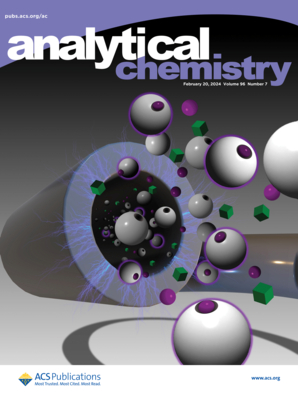基于通用主客策略的自动图像处理辅助比例余辉传感器阵列识别和检测氟喹诺酮类药物。
IF 6.7
1区 化学
Q1 CHEMISTRY, ANALYTICAL
引用次数: 0
摘要
氟喹诺酮(FQ)亚型由于其分子结构和光学性质高度相似,因此同时检测和鉴别至关重要,但具有挑战性。在这项工作中,我们提出了一种比例余辉传感器阵列,通过通用主客体掺杂策略对五种FQ亚型进行视觉检测和区分。用硼酸作为万能载体,通过形成刚性基体和交联网络,增强了蓝色发射FQs、绿色发射1-萘硼酸和红色发射1-芘硼酸的余辉发射强度。将余辉检测与自动图像处理相结合,无需复杂的仪器就能对FQs进行人脸检测。通过对这些FQs余辉强度的差异性和相似性进行模式识别分析,实现了5种FQs的检测和辨别,最低可达0.27 ng/mL。此外,该传感器阵列在商品肉类样品中混合FQs的检测和区分方面表现出优异的性能。本研究为抗生素的检测和鉴别提供了一种简便易行的方法,在环境监测和食品安全评价中具有广阔的应用前景。本文章由计算机程序翻译,如有差异,请以英文原文为准。
Automatic Image Processing-Assisted Ratiometric Afterglow Sensor Array for the Discrimination and Detection of Fluoroquinolones Enabled by a Universal Host-Guest Strategy.
Simultaneous detection and discrimination of fluoroquinolone (FQ) subtypes are crucial yet challenging due to their high similarity in molecular structure and optical properties. In this work, we propose a ratiometric afterglow sensor array for the visual detection and discrimination of five FQ subtypes via a universal host-guest doping strategy. Boric acid was used as a universal host to boost the afterglow emission intensities of blue emissive FQs, green emissive 1-naphthaleneboronic acid, and red emissive 1-pyrenylboronic acid by creating a rigid matrix and cross-linked networks. After combination of afterglow detection with automatic image processing, FQs could be facially detected without complicated instruments. By conducting pattern recognition analysis on the disparities and similarities in the afterglow intensities of these FQs, the detection and discrimination of five FQs were realized, as low as 0.27 ng/mL. In addition, the sensor array exhibited excellent performance in detecting and discriminating mixed FQs in commercial meat samples. This study provided a straightforward approach for the detection and discrimination of antibiotics, holding great promise for applications in environmental monitoring and food safety assessment.
求助全文
通过发布文献求助,成功后即可免费获取论文全文。
去求助
来源期刊

Analytical Chemistry
化学-分析化学
CiteScore
12.10
自引率
12.20%
发文量
1949
审稿时长
1.4 months
期刊介绍:
Analytical Chemistry, a peer-reviewed research journal, focuses on disseminating new and original knowledge across all branches of analytical chemistry. Fundamental articles may explore general principles of chemical measurement science and need not directly address existing or potential analytical methodology. They can be entirely theoretical or report experimental results. Contributions may cover various phases of analytical operations, including sampling, bioanalysis, electrochemistry, mass spectrometry, microscale and nanoscale systems, environmental analysis, separations, spectroscopy, chemical reactions and selectivity, instrumentation, imaging, surface analysis, and data processing. Papers discussing known analytical methods should present a significant, original application of the method, a notable improvement, or results on an important analyte.
 求助内容:
求助内容: 应助结果提醒方式:
应助结果提醒方式:


